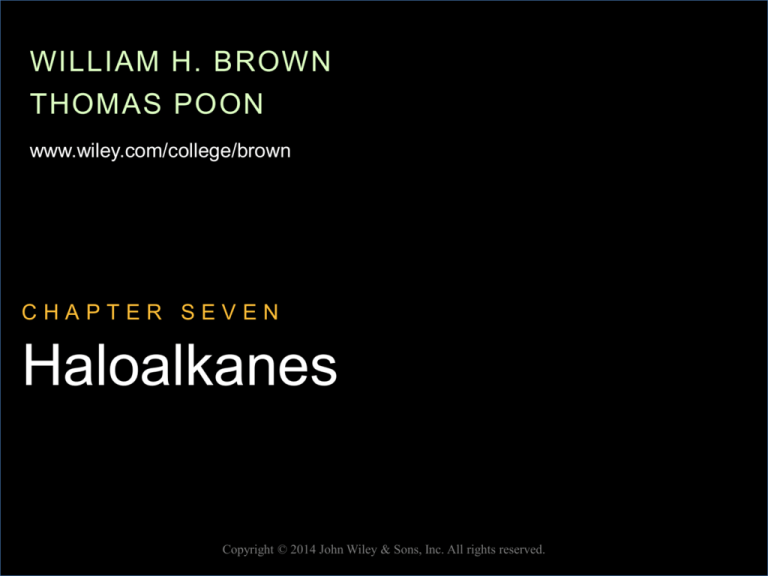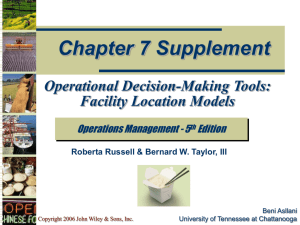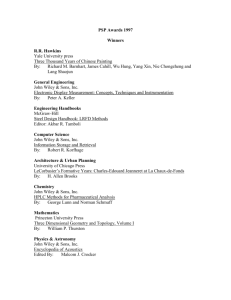
WILLIAM H. BROWN
THOMAS POON
www.wiley.com/college/brown
CHAPTER SEVEN
Haloalkanes
Copyright © 2014 John Wiley & Sons, Inc. All rights reserved.
7-1
Structure
• Haloalkane (alkyl halide): A compound
containing a halogen atom covalently bonded
to an sp3 hybridized carbon.
– given the symbol RX
Copyright © 2014 John Wiley & Sons, Inc. All rights reserved.
7-2
Nomenclature - IUPAC
– Locate the parent alkane.
– Number the parent chain to give the substituent
encountered first the lower number.
– Show halogen substituents by the prefixes fluoro, chloro-, bromo-, and iodo- and list them in
alphabetical order with other substituents.
– Locate each halogen on the parent chain.
Copyright © 2014 John Wiley & Sons, Inc. All rights reserved.
7-3
Nomenclature
• Several polyhaloalkanes are common
solvents and are generally referred to by their
common or trivial names.
Copyright © 2014 John Wiley & Sons, Inc. All rights reserved.
7-4
Freons & Their Alternatives
• The Freons are chlorofluorocarbons (CFCs)
– Among the most widely used are/were
– Much lower ozone-depleting alternatives are the
hydrofluorocarbons (HFCs) and the
hydrochlorofluorocarbons (HCFCs), including
Copyright © 2014 John Wiley & Sons, Inc. All rights reserved.
7-5
Substitution & Elimination
• In this chapter we, concentrate on two types
of reactions:
Copyright © 2014 John Wiley & Sons, Inc. All rights reserved.
7-6
Nucleophilic Substitution
• In the following general reaction, substitution
takes place on an sp3 hybridized (tetrahedral)
carbon.
Copyright © 2014 John Wiley & Sons, Inc. All rights reserved.
7-7
Nucleophilic Substitution
Copyright © 2014 John Wiley & Sons, Inc. All rights reserved.
7-8
Mechanism
• Chemists propose two limiting mechanisms
for nucleophilic substitutions.
– A fundamental difference between them is the
__________ of bond breaking and bond forming
steps.
• At one extreme, the two processes take place
simultaneously;______________________.
–S=
–N=
–2=
– rate = k[haloalkane][nucleophile]
Copyright © 2014 John Wiley & Sons, Inc. All rights reserved.
7-9
SN 2
– Both reactants are involved in the transition state
of the rate-determining step.
– The nucleophile attacks the reactive center from
_____________________ the leaving group. The
key step is reaction of a nucleophile and an
electrophile to form a new covalent bond.
Copyright © 2014 John Wiley & Sons, Inc. All rights reserved.
7-10
SN 2
• Figure 7.1 An
energy diagram
for an SN2
reaction.
– There is one
transition state
and no reactive
intermediate.
Copyright © 2014 John Wiley & Sons, Inc. All rights reserved.
7-11
SN 1
• In the other limiting mechanism, bond
breaking between carbon and the leaving
group is ______________________before
bond forming with the nucleophile begins.
• This mechanism is designated SN1 where
– S = substitution
– N = nucleophilic
–1=
– rate = k[haloalkane]
Copyright © 2014 John Wiley & Sons, Inc. All rights reserved.
7-12
SN 1
• SN1 is illustrated by the solvolysis* of tertbutyl bromide.
– Step 1: Break a bond to form a stable ion or
molecule. Ionization of the C-X bond gives a
carbocation.
*A reaction in which a solvent molecule (like water or alcohol) is also one of the reactants
Copyright © 2014 John Wiley & Sons, Inc. All rights reserved.
7-13
SN 1
– Step 2: Reaction of a nucleophile and an
electrophile to form a new covalent bond.
– Step 3: Take a proton away. Proton transfer to
methanol completes the reaction.
Copyright © 2014 John Wiley & Sons, Inc. All rights reserved.
7-14
SN 1
Figure 7.2 An
energy diagram for
an SN1 reaction.
There are two
transition states
and one
intermediate.
Copyright © 2014 John Wiley & Sons, Inc. All rights reserved.
7-15
SN1 and Carbocation Rearrangements
When an SN1 reaction occurs from a 2°
haloalkane, a 2° carbocation is formed, which is
prone to rearrange to a more stable 3°
carbocation (Section 5.4).
Copyright © 2014 John Wiley & Sons, Inc. All rights reserved.
7-16
SN 1
• For an SN1 reaction at a stereocenter, the
product is a racemic mixture.
Copyright © 2014 John Wiley & Sons, Inc. All rights reserved.
7-17
Evidence for SN Reactions
• Let us examine some of the experimental
evidence on which these two mechanisms
are based and, as we do, consider the
following questions.
– What affect does the structure of the
_______________ have on the rate of reaction?
– What effect does the structure of the
_______________ have on the rate of reaction?
– What effect does the structure of the ________
_________have on the rate of reaction?
– What is the role of the _____________?
Copyright © 2014 John Wiley & Sons, Inc. All rights reserved.
7-18
Nucleophilicity
• Nucleophilicity: a kinetic property measured
by the rate at which a Nu: attacks a reference
compound under a standard set of
experimental conditions.
– For example, the rate at which a set of
nucleophiles displaces bromide ion from
bromoethane in ethanol at 25 °C.
• Table 7.2 shows common nucleophiles and
their relative nucleophilicities
Copyright © 2014 John Wiley & Sons, Inc. All rights reserved.
7-19
Relative Nucleophilicity
Copyright © 2014 John Wiley & Sons, Inc. All rights reserved.
7-20
Summary
• Consider the rate of each reaction type:
– Sn2: rate = k[haloalkane][nucleophile]
– Sn1: rate = k[haloalkane]
• Because the rate of the nucleophile is only
considered in Sn2 mechanisms, the following
conclusion can be drawn:
Copyright © 2014 John Wiley & Sons, Inc. All rights reserved.
7-21
Summary
• Strong Nucleophiles favor _____ mechanism
• Weak nucleophiles disfavors Sn2 mechanism
and allows the Sn1 mechanism to compete
successfully
• Blue book problems 9.12 – 9.17 (p. 217)
Copyright © 2014 John Wiley & Sons, Inc. All rights reserved.
7-22
Structure of the Haloalkane
• SN1 reactions
– Governed by __________________, namely the
relative stabilities of carbocation intermediates.
– Relative rates:
• SN2 reactions
– Governed by __________________, namely the
relative ease of approach of the nucleophile to
the site of reaction.
– Relative rates:
Copyright © 2014 John Wiley & Sons, Inc. All rights reserved.
7-23
Structure of the Haloalkane
• Steric factors
– Compare access to the reaction center in
bromoethane and 2-bromo-2-methylpropane
(tert-butyl chloride).
Copyright © 2014 John Wiley & Sons, Inc. All rights reserved.
7-24
Structure of the Haloalkane
• Figure 7.3 Effect of electronic and steric
factors in competition between SN1 and SN2
reactions of haloalkanes.
Blue Book 9.2 – 9.5 and 9.7 – 9.10 (p. 214)
Copyright © 2014 John Wiley & Sons, Inc. All rights reserved.
7-25
The Leaving Group
– The best leaving groups in this series are the
halogens I–, Br–, and Cl–. (Generally, Good LG
are conjugate bases of strong acids!)
– OH–, RO–, and NH2– are such poor leaving
groups that they are rarely if ever displaced in
nucleophilic substitution reactions.
Copyright © 2014 John Wiley & Sons, Inc. All rights reserved.
7-26
The Leaving Group
• Hydroxide ion, OH–, is a poor leaving.
However, the –OH group of an alcohol can act
as a leaving group, H2O, if the –OH group is
first protonated by an acid to form —OH2+, a
better leaving group.
Copyright © 2014 John Wiley & Sons, Inc. All rights reserved.
7-27
Blue Book page 218 & 219
Blue Book 9.19 – 9.26
Copyright © 2014 John Wiley & Sons, Inc. All rights reserved.
7-28
The Solvent
• Protic solvent: a solvent that contains an
–OH group and is a hydrogen bond donor.
Copyright © 2014 John Wiley & Sons, Inc. All rights reserved.
7-29
The Solvent
• Aprotic solvent: A solvent that does not contain an
–OH group and is not a hydrogen bond donor.
– Aprotic solvents favor SN2 reactions. Although the
solvents at the top of the table are polar, formation of
carbocations in them is more difficult than in protic
solvents.
Copyright © 2014 John Wiley & Sons, Inc. All rights reserved.
7-30
Summary of SN1 and SN2 Reactions of Haloalkanes
Copyright © 2014 John Wiley & Sons, Inc. All rights reserved.
7-31
Nucleophilic Substitution
– Example: Predict the product of each reaction, its
mechanism, and the stereochemistry of the
product.
For more practice, blue book
page 224: 9.30 – 9.35
Copyright © 2014 John Wiley & Sons, Inc. All rights reserved.
7-32
b-Elimination
• β-Elimination: Removal of atoms or groups
of atoms from adjacent carbons to form a
________________________________.
– We study a type of b-elimination called
____________________ (the elimination of HX).
Copyright © 2014 John Wiley & Sons, Inc. All rights reserved.
7-33
b-Elimination
• Zaitsev’s rule: The major product of a β-elimination
is the more stable (the more highly substituted)
alkene. When cis-trans isomerism is possible, the
trans isomer is favored.
Copyright © 2014 John Wiley & Sons, Inc. All rights reserved.
7-34
b-Elimination
• There are two limiting mechanisms for
β-elimination reactions.
• E1 mechanism: at one extreme, breaking of
the C-X bond is complete before reaction with
base breaks the C-H bond.
– Only R-X is involved in the rate-determining step.
• E2 mechanism: at the other extreme,
breaking of the C-X and C-H bonds is
concerted.
– Both R-X and base are involved in the ratedetermining step.
Copyright © 2014 John Wiley & Sons, Inc. All rights reserved.
7-35
E1 Mechanism
– Step 1: Break a bond go give a stable molecule or ion.
Rate-determining ionization of C-X gives a carbocation
intermediate and halide ion.
– Step 2: Take a proton away. Proton transfer from the
carbocation to a base (in this case, the solvent) gives the
alkene.
Copyright © 2014 John Wiley & Sons, Inc. All rights reserved.
7-36
E2 Mechanism
• A one-step mechanism; all bond-breaking
and bond-forming steps are concerted.
Simultaneously (1) take a proton away and
(2) break a bond to form a stable ion or
molecule.
Copyright © 2014 John Wiley & Sons, Inc. All rights reserved.
7-37
Elimination Reactions
Copyright © 2014 John Wiley & Sons, Inc. All rights reserved.
7-38
Substitution versus Elimination
• Because many nucleophiles are also strong
bases (OH– and RO–), SN and E reactions
often compete.
– The ratio of SN/E products depends on the
_____________________ of the two reactions.
Copyright © 2014 John Wiley & Sons, Inc. All rights reserved.
7-39
SN1 versus E1
• Reactions of 2° and 3° haloalkanes in polar protic
solvents give mixtures of substitution and
elimination products. Product ratios are difficult to
predict.
Copyright © 2014 John Wiley & Sons, Inc. All rights reserved.
7-40
SN2 versus E2
• It is considerably easier to predict the ratio of
SN2 to E2 products.
Copyright © 2014 John Wiley & Sons, Inc. All rights reserved.
7-41
Summary of SN versus E for Haloalkanes
– Examples: Predict the major product and the
mechanism for each reaction.
Copyright © 2014 John Wiley & Sons, Inc. All rights reserved.
7-42







